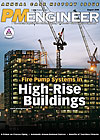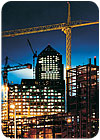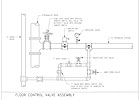
Determining the proper size and arrangement for sprinkler/standpipe/fire pump systems in high-rise buildings can be a straightforward task, but it requires establishing the correct code and insurance requirements before beginning the design process.
Codes and Standards
Large municipalities such as New York and Chicago have maintained their own individual codes, which are quite specific with respect to the design requirements, arrangement and operations of sprinkler/standpipe/fire pump systems. In contrast, smaller towns and cities have adopted, and/or modified by amendment, one of the model codes, such as the International Building Code.
Adding to the design uncertainty is the fact that all of the codes reference varying editions of the pertinent NFPA design standards regarding sprinklers, standpipes and fire pump installations, and often recognize only some portions of these standards and disregard others.
Insurance Requirements
The building owner's insurance underwriter may wish to review the proposed systems' design to make recommendations for the lowest rates of insurance. However, often the additional costs of the recommendations vs. standard "code minimum"
Sprinklers
Next, the engineer/designer must establish whether sprinkler protection is to be provided for the project. When a building occupancy involves situations where individuals may not be fully conscious, ambulatory or readily capable of taking action for self-preservation in a developing fire event, sprinklers should be recommended, if not required by code. These situations include actual physical lock-down for criminal and psychiatric/dementia supervision; incapacitation for illness, medical evaluation and drug therapies; and sleeping individuals in hotels and living residences. The current edition of the International Building Code requires sprinklers in all high-rise buildings. Sprinklers, if not required by the code, should be recommended for residential occupancies in large mixed-use buildings where occupancies of a higher fire hazard-such as parking, restaurants, clubs, entertainment, casinos, retail with inventory storage, etc.-are located below the living/sleeping residences.
The modern residential sprinkler's quick response and spray pattern configuration can delay or prevent flashover, which is the point in a fire event where a small developing fire within a confined cubicle has heated and dried all the latent moisture from the room and its contents. As a result, everything within the cubicle ignites almost simultaneously, producing an aggressive, thick, choking black smoke that is driven rapidly by the high heat into distant parts of the building. In contrast, smoke developed from a fire that has activated one or more modern sprinklers is thin, grey, less aggressive and ultimately more survivable to those who may come into contact with it.
Design Tasks and Information
The engineer/designer must examine the architectural/structural documents for information to confirm several things:
- The highest stairwell-accessible, normally occupied floor and its elevation above grade entry level;
- The elevation of the highest required sprinkler system;
- Intended location and adequate room size for the necessary fire pump equipment;
- The number of required egress stairwells, and that the size of stairwell interiors provides adequate room for fire dept. valves on standpipes. The stairwells should also leave room for the inclusion of necessary express risers and/or combined sprinkler/standpipe and drain risers without encroachment into the egress turn-around radius at each floor or intermediate landing;
- There is adequate space and headroom (minimum 7' 0") for system control valves.
After this, the engineer/designer must examine the code requirements and speak with the Authority Having Jurisdiction (AHJ) to confirm and determine:
- The residual flow and pressure required at the most remote standpipe or combined sprinkler/standpipe;
- The Class of standpipe protection necessary (I, II or III) and any additional appurtenances for standpipe connections and equipment the fire department may currently request;
- The maximum pressure allowed for the system at the churn conditions;
- If the fire pump is required to be connected to an emergency source of power (such as a diesel-driven emergency generator set) or secondary source of power from a separate electrical sub-station;
- The desired location of the standpipe and fire department connection within the stairwell enclosure, either on the main or intermediate landing.
Standpipes
Most codes establish the flow rate for the fire pump or pumps directly, or by referring to an NFPA 14 edition, based on the number of required standpipes. Generally, it's 500 gpm for the first standpipe and 250 gpm for each additional standpipe, to a maximum of 1,250 to 1,500 gpm, depending on code or standard edition referenced.The number of required standpipes may be equal to the number of required egress stairwells (one in each required stairwell) or may be dictated by coverage of all areas of all floor plans-from standpipes located within the reach of a specified length of hose and water stream discharge of a nozzle, directed into the most remote rooms.
Placement of standpipes should begin with one in each required egress stairwell, and if additional ones are required to meet the length of hose and stream coverage requirement, they are placed outside the stairwells.
The majority of high-rise buildings are used for office and residential occupancy, and both these occupancy classifications are light hazard sprinkler demands, and therefore do not represent the most hydraulically demanding sprinkler requirement. Ordinary hazard sprinkler demands-such as those present at cooling towers; mechanical, electrical or elevator machine rooms located at the top of the building; or larger areas of ordinary hazard occupancies below the tower portion of the building-should be identified and evaluated as more demanding factors for sizing the fire pump.
The hydraulically worst-case sprinkler demand is usually added to the NFPA 14 standpipe demand for pump sizing, although some codes recognize that not more than two to three standpipes will be used by firefighting personnel in a single fire event for mop-up operations in a fully sprinklered building. Therefore, some codes permit sizing of the fire pump to be half the gross standpipe demand, plus the worst-case sprinkler demand.
Part II of this article will discuss: The residual pressures required at the top outlets; the arrangement and sizes of standpipes, mains and express risers that are to be specified by the engineer/designer; series and parallel pumping; drives; emergency sources of power and means to reduce churn; and residual pressures in multiple pumping systems.

SIDEBAR: Design Exception: Code May Provide for Standpipe/Sprinkler Systems Without a Fire Pump
Design situations that have a high residual water-main pressure and are 5-8 stories in height may avoid the inclusion of a fire pump with the sprinkler/standpipe system altogether. If the street pressure satisfies the hydraulic demand requirements for the sprinkler system, a fire pump is not necessary for the sprinkler system or standpipe. This exception is based on the building being completely sprinklered by an NFPA 13 system. The standpipe pressure can be satisfied by the fire department pumper connecting to the fire department connection for the systems. The Class I standpipe connections are considered for use by the fire department only.Projects in this category also are quite often budget-sensitive, and may further avoid costs by having the base of the standpipe and sprinkler risers supervised and controlled with outside screw and yoke gates. These gates are chained and pad-locked in the open position and use an alarm check valve to drive an exterior water motor gong, which sounds the necessary alarm required when a single sprinkler operates. This design avoids the need for an electronic fire alarm system to supervise tamper switches and water flow, if such a system is not otherwise required by the code.
Equally important, this design effectively makes the entire building a single sprinkler zone, which is permitted to a maximum of 52,000 sq. ft. by NFPA 13, but leaves specific drawbacks with respect to the maintenance time of replacing a sprinkler that has activated or become damaged. All levels above the damaged or activated sprinkler will need to be drained down to permit maintenance at that level needing repair, and then refilled when repairs are completed. This removes sprinkler protection for the duration of the repairs from many unaffected levels above, when the occurrence is at a lower level of the building. If the project is strictly residential, where unit layouts are not normally revised frequently, this situation may be okay, but prove difficult if it is an office occupancy or offices with residences above as office layouts are typically revised with each tenant change, leaving the floors above without sprinkler protection. Regardless of occupancy, buildings of more than 10 stories are better served with each floor supervised and controlled as a separate sprinkler zone, as represented by Figure 1 on page 20.